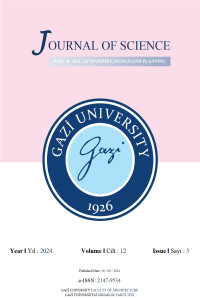Öz
Proje Numarası
yok
Kaynakça
- [1] Arabacıoğlu, F.P., Aydemir, I. (2007). The concept of re-evaluation in historic environments. Megaron Journal, 2(4), 204-212.
- [2] Demirkol, R.S. (2021). Cappadocia in the context of historical environmental protection. ART/icle: Art and Design Journal, 1(1), 43-63.
- [3] Şahin, İ. (1990). An Auxiliary Research on the Protection of Immovable Cultural and Natural Heritage in Turkey and Public Participation in Protection. Master Thesis, Istanbul Technical University, Institute of Science, İstanbul.
- [4] Zeren, M.T. New Addition and New Building Phenomenon in the Historic Environment Examples of Contemporary Approaches, Yalın Publishing, Istanbul, 2010.
- [5] Ahunbay, Z. Historic Environment Protection and Restoration, Yem Publication, Istanbul, 1996.
- [6] Soyupak, S., Cardak, F. S. (2024). Investigation of New Design Approaches in the Historic Environment Through the Case of Tarsus Gözlükule Excavations Research Center, İdealkent, 15(42), 844-870.
- [7] Kılıç, A. (2015). Norman Foster buildings in the context of new building-new addition in the historic environment. Master Thesis, Erciyes University, Institute of Science, Kayseri.
- [8] Velioğlu, A. (1992). A research on architectural design and process in historical environment. PhD Thesis, Karadeniz Technical University, Institute of Science, Trabzon.
- [9] Ateş Can, S., Uyguralp, Ö. (2022). New building/addition and context relationship in the historic environment. Mehmet Akif Ersoy University Institute of Science Journal, 13(1), 27-39.
- [10] Yapan, M., Büyükmıhcı, G. (2023). Tarihi Dokuda Çağdaş Ek Tasarımı: Kemaliye Örneği, Palmet Journal, (3), 67-90.
Öz
Historical textures are the representatives of cultural heritage that convey the way of life, economic and sociocultural structure of the people living in the past and the technology of that period. Many reasons such as urbanization problems, migration, war, natural disasters, epidemics, economic problems, new construction tendency, change in education and lack of awareness make it difficult to preserve the historical texture and transfer it to the future. The addition or reconstruction of new buildings within the historic fabric emerges as a design problem in terms of providing historical and cultural continuity. Diyarbakır, a historical city in southeastern Turkey, has been home to many civilizations from past to present. The Suriçi District of Diyarbakır, which has preserved its historical and physical texture for many years, underwent a major change after the armed conflict in 2015. Instead of the demolished buildings in the district, after a very rapid design process, the traditional street texture was destroyed and new buildings were designed that evoke the design styles of traditional houses. The aim of this study is to examine the new buildings designed as a result of the reconstruction of Yenikapı Street in Diyarbakır Suriçi District after 2016 in line with new building design approaches in the historical environment and to evaluate them within the criteria of new construction in the historical environment. In this context, in the research process; after conducting a literature research, the historical environment, new building in the historical environment and new building design approaches in the historical environment were examined, the situation of Yenikapı Street before and after the demolition was analyzed, and determinations were made in line with the criteria for new construction in the historical environment.
Anahtar Kelimeler
Historic Environment Diyarbakır Houses Traditional Texture New Construction
Etik Beyan
Etik beyana gerek görülmemiştir.
Destekleyen Kurum
yok
Proje Numarası
yok
Teşekkür
yok
Kaynakça
- [1] Arabacıoğlu, F.P., Aydemir, I. (2007). The concept of re-evaluation in historic environments. Megaron Journal, 2(4), 204-212.
- [2] Demirkol, R.S. (2021). Cappadocia in the context of historical environmental protection. ART/icle: Art and Design Journal, 1(1), 43-63.
- [3] Şahin, İ. (1990). An Auxiliary Research on the Protection of Immovable Cultural and Natural Heritage in Turkey and Public Participation in Protection. Master Thesis, Istanbul Technical University, Institute of Science, İstanbul.
- [4] Zeren, M.T. New Addition and New Building Phenomenon in the Historic Environment Examples of Contemporary Approaches, Yalın Publishing, Istanbul, 2010.
- [5] Ahunbay, Z. Historic Environment Protection and Restoration, Yem Publication, Istanbul, 1996.
- [6] Soyupak, S., Cardak, F. S. (2024). Investigation of New Design Approaches in the Historic Environment Through the Case of Tarsus Gözlükule Excavations Research Center, İdealkent, 15(42), 844-870.
- [7] Kılıç, A. (2015). Norman Foster buildings in the context of new building-new addition in the historic environment. Master Thesis, Erciyes University, Institute of Science, Kayseri.
- [8] Velioğlu, A. (1992). A research on architectural design and process in historical environment. PhD Thesis, Karadeniz Technical University, Institute of Science, Trabzon.
- [9] Ateş Can, S., Uyguralp, Ö. (2022). New building/addition and context relationship in the historic environment. Mehmet Akif Ersoy University Institute of Science Journal, 13(1), 27-39.
- [10] Yapan, M., Büyükmıhcı, G. (2023). Tarihi Dokuda Çağdaş Ek Tasarımı: Kemaliye Örneği, Palmet Journal, (3), 67-90.
Ayrıntılar
| Birincil Dil | İngilizce |
|---|---|
| Konular | Mimari Miras ve Koruma, Mimari Tasarım, Mimarlık (Diğer), Yapı, Çevre, Yerleşim ve Ürünlerde Koruma, Restorasyon, Yenileme |
| Bölüm | Mimarlık |
| Yazarlar | |
| Proje Numarası | yok |
| Yayımlanma Tarihi | 30 Eylül 2024 |
| Gönderilme Tarihi | 10 Temmuz 2024 |
| Kabul Tarihi | 7 Eylül 2024 |
| Yayımlandığı Sayı | Yıl 2024 Cilt: 12 Sayı: 3 |


